Sent by a reader in Microplastics Capital of NZ
Tiny time bombs releasing toxins in parts of our body where other weapons cannot reach
To keep our minds at rest, the only land animals in which the consumption of microplastics has been closely studied are two species of earthworm and a nematode.

Microbeads are tiny plastic particles used as an abrasive in many personal care products. They are commonly found in products like facial scrubs, soaps and shampoos. Credit: greatlakes.org/campaigns/microbead-menace/
Microplastics, or microbeads, and tiny plastic fibers and fragments, absorb toxic chemicals commonly found in the water. They are mistaken for food by small fish and wildlife, which are consumed by larger animals and humans.
However, the biggest proportion of microplastic pollution “are fibres shed by synthetic textiles and tyre dust from roads, with more from the breakdown of waste plastics.”
According to a recent research, published in the journal Environmental Science and Technology, about 430,000 tonnes of microplastics are being added to European fields each year, and 300,000 tonnes in North America. [China’s share would be about 500,000 tonnes, with India and ROW contributing an additional 750,000 tonnes.]
“The scale of global microplastic contamination is only starting to become clear, with studies in Germany finding fibres and fragments in all of the 24 beer brands they tested, as well as in honey and sugar. In Paris in 2015, researchers discovered microplastic falling from the air, which they estimated deposits three to 10 tonnes of fibres on the city each year, and that it was also present in the air in people’s homes.”
Microplastics have also infested the world’s drinking water.
About 83 percent of the drinking water samples collected on five continents tested positive for the presence of plastic fibers, says Orb Media.
Sources of Invisible Plastics [Source: Orb Media]
1. SYNTHETIC FIBERS IN THE WASH
Synthetic clothes like fleece, acrylic, and polyester emit thousands of microscopic fibers with every wash. An estimated 1 million tons of these tiny fibers are discharged into wastewater each year, where more than half evade treatment and escape into the environment.
2. TIRE DUST
Styrene butadiene tire dust is washed into sewers, and from there into streams, rivers, and oceans. Cars and trucks emit more than 20 grams of tire dust for every 100 kilometers they drive. It adds up. Norway [population 5.3 million,] for example, produces a kilogram of tire and road dust each year for every Norwegian woman, man, and child.
[Norwegian vehicles were driven 44.3 billion kilometres on Norwegian and international roads in 2015. Comparably, total distance driven in New Zealand [population 4.8 million] is estimated at about 45 billion kilometres in 2015.]
3. PAINTS
Dust from road markings, ship paint, and house paint contribute more than 10 percent of
microplastic pollution in the oceans. Studies show that paint dust coats the ocean surface.
4. SECONDARY MICROPLASTICS
At least 8 million tons of mishandled plastic waste washes into the world’s oceans, rivers and lakes each year. These forks, bags, straws, and takeout containers churn and fragment in the frigid seas, breaking down into ever-smaller pieces to join the marine and human food chains — the microplastics of the future. We have produced more plastic in the last 10 years than in the entirety of the last century.
5. SYNTHETIC FIBERS IN THE AIR
Scientists are only beginning to examine how microscopic fibers reach the atmosphere, and their role as a source of land and marine pollution. One guess is that common abrasion
— the simple friction of your limbs brushing against each other — causes clothing fibers to
break off into the air. like a cat shedding fur. A 2015 study in Paris estimated that between
three and 10 tons of airborne fibers reach that city’s surface each year.
6. MICROBEADS
Banned in facial cleaners and some cosmetics in the US. and Canada, it is estimated that more than 8 trillion microbeads polluted U.S. waterways in 2015.
Microplastics in Auckland Water
Up to 15 per cent of Auckland’s tap water is taken from the Waikato River, downstream from the city of Hamilton and wastewater treatment plants.
“Plastic microfibres leach endocrine-disrupting chemicals and carry persistent organic pollutants in increasing concentrations up through our food chain,” said Dr Trisia Farrelly, who co-founded the New Zealand Product Stewardship Council, and specialised in research on plastic waste.
Microfibres were now present in most fish tested in New Zealand, she said.
